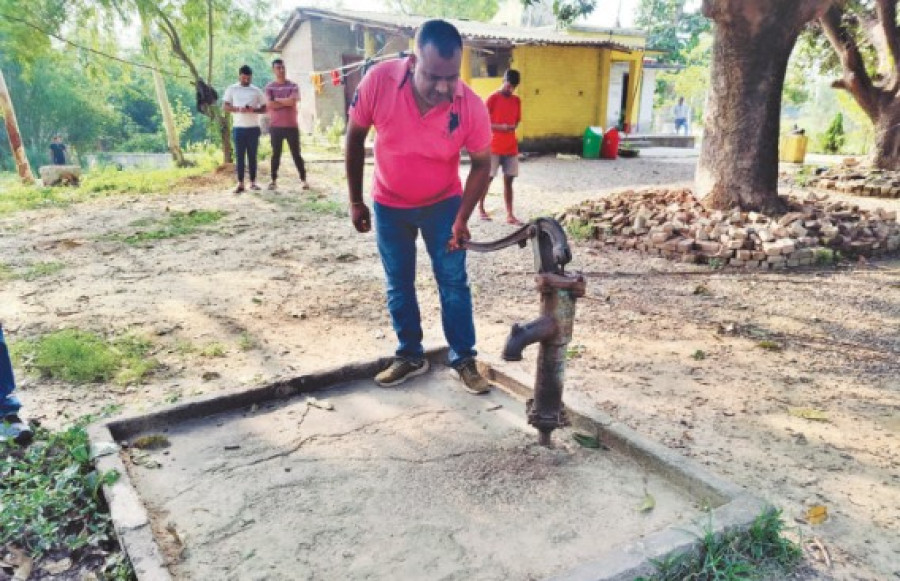Madhesh Province
A Bardibas settlement struggles with water shortages as sources dry up
Chure destruction and long drought have disrupted the water recharge system in the Tarai, says researcher.
Sunita Baral
Juri Bazaar area in ward 12 of Bardibas Municipality in Mahottari, is currently reeling under a severe shortage of water. Until five years back there were abundant natural sources of water to meet the needs of the locals. But these sources, including underground water, have dried up in recent years, leaving the locals desperate for a solution.
“Around 1,000 households in Akawantol, Chalki, Juri Bazaar, Devnagar, Abhimantol and Islamtol in ward 12 of Bardibas have been grappling with acute shortage of water, mainly during the dry season,” said Ram Kishwor Sah, ward chairman of ward 12 of Bardibas. According to him, the water crisis has worsened markedly over the past three years.
Juri Bazaar lies in Bhawar, the area between Chure and Tarai. The Juri stream and Ankushe pond spreading in around 10 bigha [6.77 hectares] of land in the area have dried up now. Similarly, the wells and shallow tube wells have also dried up in recent days. The locals have been making do with the water from the deep borewells constructed at a local school and the ward office.
Binita Sah from ward 12 of Bardibas wakes up at around 4am to manage water. She has to reach the ward office, which is around 20 minutes walk from her house, to fetch water. “I have to go to the ward office to fetch water. My entire morning is spent managing water,” lamented Binita.
Rahiman Khatun of Chalki shares a similar struggle. “I have to walk for half an hour to reach the local school to bring water from a deep borewell. We have to wait in a queue for about 20 minutes for a bucket of water. This has been my routine for the past five months,” said Rahiman. According to her, the hand pump at her house ran dry soon after the nearby Ankushe pond near her residence dried up two years ago.
The local people complain that their daily lives have been hugely affected due to the water crisis. Production of green vegetables and other crops has been dwindling as the water sources have been drying up. “We have problems growing green vegetables, rearing livestock and maintaining sanitation due to the lack of water. The paddy field that had a natural spring until five years ago has turned into a dry area, leading to a decrease in crop production,” said Surya Narayan Mandal, another local.
In view of the water shortage at ward 12 of the municipality, the Drinking Water and Sanitation Division Office in Mahottari launched three deep borewell projects at the ward in the fiscal year 2015-16. The office had allocated Rs1.5 million to construct a deep borewell in Magartol, Rs1.5 in Ramjanakitol and Rs 5 million in Dandatol during the same fiscal year. However, all three drinking water projects remain incomplete.
Brijesh Yadav, sub-engineer at the division office, said that the drinking water projects could not be completed due to a lack of budget. “The centre [federal government] did not allocate the required budget as per the detailed project report. Two of the projects are in the final stages. They will come into operation by the end of the current fiscal year,” said Yadav.
In an initiative of the ward office, drinking water is being distributed from three deep borewells—located at Nepal Rastriya Secondary School, the ward office, and a private paddy field—twice a day, in the morning and evening.
Bijaya Singh, a researcher on Chure conservation, says that water shortage in Bardibas is mainly caused by the Chure destruction and prolonged drought. “The unchecked deforestation and haphazard extraction of sand and stones by digging pits, up to 30 feet deep, in the Chure area disrupt the water recharge system, leading to a water crisis in the Chure foothills, Bhawar and the Tarai,” said Singh.
Chure extends over Bhutan, Nepal, India and Pakistan
The Chure range features a series of low hills extending over Bhutan, Nepal, India, and Pakistan. In Nepal it stretches from Mechi in the east to Mahakali in the west along the south of the Mahabharat hills. The range is around 20-30 km wide and 1,000 km long. Natural sources of water originating from the foothills of Chure are gradually drying up in the last few years, causing depletion of the first layer of underground water in Bhawar and Tarai, experts say.




 27.12°C Kathmandu
27.12°C Kathmandu













